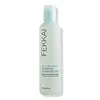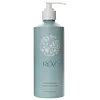What's inside
What's inside
 Key Ingredients
Key Ingredients

 Benefits
Benefits

 Concerns
Concerns

 Ingredients Side-by-side
Ingredients Side-by-side

Water
Skin ConditioningSodium Cocoyl Isethionate
CleansingSodium Lauroyl Methyl Isethionate
CleansingCocamidopropyl Betaine
CleansingCocamide Mipa
EmulsifyingSodium Methyl Oleoyl Taurate
CleansingCoconut Acid
CleansingBrassica Campestris Seed Oil
Skin ConditioningAdansonia Digitata Seed Oil
EmollientPanthenol
Skin ConditioningTocopherol
AntioxidantParfum
MaskingDisodium PEG-12 Dimethicone Sulfosuccinate
CleansingPCA Dimethicone
Skin ConditioningAminomethyl Propanol
BufferingButylene Glycol
HumectantSesamum Indicum Seed Oil
EmollientEmblica Officinalis Fruit Extract
Skin ConditioningPropanediol
SolventSodium PCA
HumectantPolyquaternium-73
Coco-Glucoside
CleansingLauryl Glucoside
CleansingSodium Isethionate
CleansingCaprylyl Glycol
EmollientEthylhexylglycerin
Skin ConditioningSodium Hydroxide
BufferingGuar Hydroxypropyltrimonium Chloride
Skin ConditioningTetrasodium Glutamate Diacetate
Citric Acid
BufferingSodium Benzoate
MaskingPhenoxyethanol
PreservativeCoumarin
PerfumingWater, Sodium Cocoyl Isethionate, Sodium Lauroyl Methyl Isethionate, Cocamidopropyl Betaine, Cocamide Mipa, Sodium Methyl Oleoyl Taurate, Coconut Acid, Brassica Campestris Seed Oil, Adansonia Digitata Seed Oil, Panthenol, Tocopherol, Parfum, Disodium PEG-12 Dimethicone Sulfosuccinate, PCA Dimethicone, Aminomethyl Propanol, Butylene Glycol, Sesamum Indicum Seed Oil, Emblica Officinalis Fruit Extract, Propanediol, Sodium PCA, Polyquaternium-73, Coco-Glucoside, Lauryl Glucoside, Sodium Isethionate, Caprylyl Glycol, Ethylhexylglycerin, Sodium Hydroxide, Guar Hydroxypropyltrimonium Chloride, Tetrasodium Glutamate Diacetate, Citric Acid, Sodium Benzoate, Phenoxyethanol, Coumarin
Water
Skin ConditioningSodium Cocoyl Isethionate
CleansingLauryl Glucoside
CleansingSodium C14-16 Olefin Sulfonate
CleansingSodium Lauroyl Methyl Isethionate
CleansingCocamidopropyl Betaine
CleansingSodium Methyl Oleoyl Taurate
CleansingGlycerin
HumectantCoconut Acid
CleansingCoco-Glucoside
CleansingCocamide Mipa
EmulsifyingSodium Isethionate
Cleansing1,2-Hexanediol
Skin ConditioningCaprylyl Glycol
EmollientGuar Hydroxypropyltrimonium Chloride
Skin ConditioningPisum Sativum Peptide
Skin ConditioningJuglans Regia Seed Extract
Skin ConditioningSodium Gluconate
Skin ConditioningVitis Vinifera Fruit Extract
Skin ConditioningBoswellia Serrata Resin Extract
SmoothingZingiber Officinale Root Extract
MaskingVitis Vinifera Vine Sap
Skin ConditioningSodium Hydroxide
BufferingSodium Benzoate
MaskingCeramide EOP
Skin ConditioningCeramide NP
Skin ConditioningCeramide AP
Skin ConditioningEthylhexylglycerin
Skin ConditioningSorbitol
HumectantCitric Acid
BufferingLecithin
EmollientLeuconostoc/Radish Root Ferment Filtrate
AntimicrobialSodium Lauroyl Lactylate
EmulsifyingXanthan Gum
EmulsifyingGlutaral
PreservativePotassium Sorbate
PreservativePhenoxyethanol
PreservativeCholesterol
EmollientPhytosphingosine
Skin ConditioningCarbomer
Emulsion StabilisingParfum
MaskingLimonene
PerfumingGeraniol
PerfumingLinalool
PerfumingWater, Sodium Cocoyl Isethionate, Lauryl Glucoside, Sodium C14-16 Olefin Sulfonate, Sodium Lauroyl Methyl Isethionate, Cocamidopropyl Betaine, Sodium Methyl Oleoyl Taurate, Glycerin, Coconut Acid, Coco-Glucoside, Cocamide Mipa, Sodium Isethionate, 1,2-Hexanediol, Caprylyl Glycol, Guar Hydroxypropyltrimonium Chloride, Pisum Sativum Peptide, Juglans Regia Seed Extract, Sodium Gluconate, Vitis Vinifera Fruit Extract, Boswellia Serrata Resin Extract, Zingiber Officinale Root Extract, Vitis Vinifera Vine Sap, Sodium Hydroxide, Sodium Benzoate, Ceramide EOP, Ceramide NP, Ceramide AP, Ethylhexylglycerin, Sorbitol, Citric Acid, Lecithin, Leuconostoc/Radish Root Ferment Filtrate, Sodium Lauroyl Lactylate, Xanthan Gum, Glutaral, Potassium Sorbate, Phenoxyethanol, Cholesterol, Phytosphingosine, Carbomer, Parfum, Limonene, Geraniol, Linalool
Ingredients Explained
These ingredients are found in both products.
Ingredients higher up in an ingredient list are typically present in a larger amount.
Caprylyl Glycol is a humectant and emollient, meaning it attracts and preserves moisture.
It is a common ingredient in many products, especially those designed to hydrate skin. The primary benefits are retaining moisture, skin softening, and promoting a healthy skin barrier.
Though Caprylyl Glycol is an alcohol derived from fatty acids, it is not the kind that can dry out skin.
This ingredient is also used as a preservative to extend the life of products. It has slight antimicrobial properties.
Learn more about Caprylyl GlycolCitric Acid is an alpha hydroxy acid (AHA) naturally found in citrus fruits like oranges, lemons, and limes.
Like other AHAs, citric acid can exfoliate skin by breaking down the bonds that hold dead skin cells together. This helps reveal smoother and brighter skin underneath.
However, this exfoliating effect only happens at high concentrations (20%) which can be hard to find in cosmetic products.
Due to this, citric acid is usually included in small amounts as a pH adjuster. This helps keep products slightly more acidic and compatible with skin's natural pH.
In skincare formulas, citric acid can:
While it can provide some skin benefits, research shows lactic acid and glycolic acid are generally more effective and less irritating exfoliants.
Most citric acid used in skincare today is made by fermenting sugars (usually from molasses). This synthetic version is identical to the natural citrus form but easier to stabilize and use in formulations.
Read more about some other popular AHA's here:
Learn more about Citric AcidWe don't have a description for Cocamide Mipa yet.
Cocamidopropyl Betaine is a fatty acid created by mixing similar compounds in coconut oil and dimethylaminopropylamine, a compound with two amino groups.
This ingredient is a surfactant and cleanser. It helps gather the dirt, pollutants, and other impurities in your skin to be washed away. It also helps thicken a product and make the texture more creamy.
Being created from coconut oil means Cocamidopropyl Betaine is hydrating for the skin.
While Cocamidopropyl Betaine was believed to be an allergen, a study from 2012 disproved this. It found two compounds in unpure Cocamidopropyl Betaine to be the irritants: aminoamide and 3-dimethylaminopropylamine. High-grade and pure Cocamidopropyl Betaine did not induce allergic reactions during this study.
Learn more about Cocamidopropyl BetaineCoco-Glucoside is a surfactant, or a cleansing ingredient. It is made from glucose and coconut oil.
Surfactants help gather dirt, oil, and other pollutants from your skin to be rinsed away.
This ingredient is considered gentle and non-comedogenic. However, it may still be irritating for some.
Learn more about Coco-GlucosideCoconut Acid isn't fungal acne safe.
Ethylhexylglycerin (we can't pronounce this either) is commonly used as a preservative and skin softener. It is derived from glyceryl.
You might see Ethylhexylglycerin often paired with other preservatives such as phenoxyethanol. Ethylhexylglycerin has been found to increase the effectiveness of these other preservatives.
This ingredient is derived from guar gum.
It is a conditioning ingredient, meaning it helps soften skin and hair.
Lauryl Glucoside sugar- and lipid-based cleansing agent. It is created from glucose and lauryl alcohol.
This ingredient is a surfactant, making it easier to rinse oil, dirt, and other pollutants away.
A British study found lauryl glucoside to cause skin sensitivity for some people. We recommend speaking with a professional if you have concerns.
Other names for this ingredient include "Lauryl Polyglucose", "Lauryl glycoside", and "D-Glucopyranoside".
Learn more about Lauryl GlucosideParfum is a catch-all term for an ingredient or more that is used to give a scent to products.
Also called "fragrance", this ingredient can be a blend of hundreds of chemicals or plant oils. This means every product with "fragrance" or "parfum" in the ingredients list is a different mixture.
For instance, Habanolide is a proprietary trade name for a specific aroma chemical. When used as a fragrance ingredient in cosmetics, most aroma chemicals fall under the broad labeling category of “FRAGRANCE” or “PARFUM” according to EU and US regulations.
The term 'parfum' or 'fragrance' is not regulated in many countries. In many cases, it is up to the brand to define this term.
For instance, many brands choose to label themselves as "fragrance-free" because they are not using synthetic fragrances. However, their products may still contain ingredients such as essential oils that are considered a fragrance by INCI standards.
One example is Calendula flower extract. Calendula is an essential oil that still imparts a scent or 'fragrance'.
Depending on the blend, the ingredients in the mixture can cause allergies and sensitivities on the skin. Some ingredients that are known EU allergens include linalool and citronellol.
Parfum can also be used to mask or cover an unpleasant scent.
The bottom line is: not all fragrances/parfum/ingredients are created equally. If you are worried about fragrances, we recommend taking a closer look at an ingredient. And of course, we always recommend speaking with a professional.
Learn more about ParfumPhenoxyethanol is a preservative that has germicide, antimicrobial, and aromatic properties. Studies show that phenoxyethanol can prevent microbial growth. By itself, it has a scent that is similar to that of a rose.
It's often used in formulations along with Caprylyl Glycol to preserve the shelf life of products.
Sodium Benzoate is a preservative. It's used in both cosmetic and food products to inhibit the growth of mold and bacteria. It is typically produced synthetically.
Both the US FDA and EU Health Committee have approved the use of sodium benzoate. In the US, levels of 0.1% (of the total product) are allowed.
Sodium benzoate works as a preservative by inhibiting the growth of bacteria inside of cells. It prevents the cell from fermenting a type of sugar using an enzyme called phosphofructokinase.
It is the salt of benzoic acid. Foods containing sodium benzoate include soda, salad dressings, condiments, fruit juices, wines, and snack foods.
Studies for using ascorbic acid and sodium benzoate in cosmetics are lacking, especially in skincare routines with multiple steps.
We always recommend speaking with a professional, such as a dermatologist, if you have any concerns.
Learn more about Sodium BenzoateSodium cocoyl isethionate is a natural ingredient from coconut oil. It is an ultra gentle cleanser that gives a nice foam without drying the skin or impacting the skin barrier.
The amount of foam created depends on the amount of sodium cocoyl isethionate used in the product.
This ingredient also helps improve the spreadability of a product.
Learn more about Sodium Cocoyl IsethionateSodium Hydroxide is also known as lye or caustic soda. It is used to adjust the pH of products; many ingredients require a specific pH to be effective.
In small amounts, sodium hydroxide is considered safe to use. However, large amounts may cause chemical burns due to its high alkaline.
Your skin has a natural pH and acid mantle. This acid mantle helps prevent harmful bacteria from breaking through. The acid mantle also helps keep your skin hydrated.
"Alkaline" refers to a high pH level. A low pH level would be considered acidic.
Learn more about Sodium HydroxideWe don't have a description for Sodium Isethionate yet.
Sodium Lauroyl Methyl Isethionate is a cleansing ingredient. It is a surfactant, meaning it helps gather dirt, oil, and other pollutants. This helps them be rinsed away easily.
We don't have a description for Sodium Methyl Oleoyl Taurate yet.
Water. It's the most common cosmetic ingredient of all. You'll usually see it at the top of ingredient lists, meaning that it makes up the largest part of the product.
So why is it so popular? Water most often acts as a solvent - this means that it helps dissolve other ingredients into the formulation.
You'll also recognize water as that liquid we all need to stay alive. If you see this, drink a glass of water. Stay hydrated!
Learn more about Water